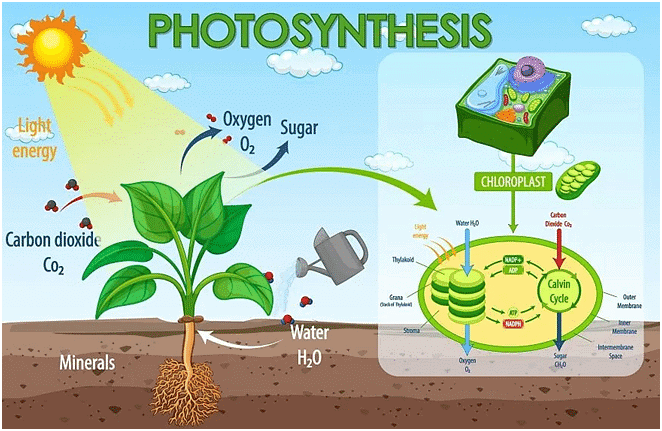Plants | GK Olympiad for Class 8 PDF Download
| Table of contents |

|
| Introduction |

|
| Types of Plants |

|
| Importance of Plants |

|
| Photosynthesis |

|
| Plant Reproduction |

|
| Importance of Preserving Plants |

|
Introduction
Plants are living organisms belonging to the kingdom Plantae. They are crucial for life on Earth as they produce oxygen through photosynthesis, provide food, materials, and are integral to ecosystems. Plants range from tiny mosses to large trees and are found in diverse environments across the globe.

Types of Plants
There are several types of plants, each adapted to different environments:
- Trees: Large, perennial plants with a distinct trunk and a crown of leaves. Examples include oak, maple, and pine trees.
- Shrubs: Smaller than trees, shrubs have multiple woody stems growing from the base. Examples include azalea and hibiscus.
- Herbs: These are non-woody plants with soft, flexible stems. Most annual and perennial flowering plants fall into this category, such as lavender and basil.
- Grasses: Members of the Poaceae family, grasses are key agricultural and ecological plants. Examples include wheat, rice, and bamboo.

Importance of Plants
Plants play several critical roles in ecosystems and human life:
- Oxygen Production: Through photosynthesis, plants convert carbon dioxide into oxygen, essential for animal and human life.
- Food Source: Plants are the primary source of food for humans and animals.
- Habitat: Forests and plant communities provide habitat for many species.
- Medicinal Resources: Many plants have medicinal properties used in pharmaceuticals.
Photosynthesis
Photosynthesis is the process by which plants convert light energy into chemical energy, producing oxygen as a byproduct. It occurs in the chloroplasts of plant cells using sunlight, water, and carbon dioxide.
The chemical equation for photosynthesis is:
Plant Reproduction
Plants reproduce both sexually and asexually:
- Sexual Reproduction: Involves the fusion of male and female gametes, leading to genetic diversity. Flowering plants use flowers to attract pollinators.
- Asexual Reproduction: Plants can reproduce without fertilization, e.g., through runners in strawberries or grafting in apple trees.

Importance of Preserving Plants
Preserving plant diversity is crucial for several reasons:
1. Biodiversity Conservation
Plants are a fundamental component of biodiversity. They serve as the primary producers in ecosystems, forming the base of the food web. Each species plays a specific role within ecological communities, contributing to the structure and function of ecosystems. Preserving a variety of plant species ensures that natural habitats are maintained, supporting diverse animal life.
2. Environmental Stability
Plants significantly contribute to the stability and health of the environment in several key ways:
- Climate Regulation: Through photosynthesis, plants absorb carbon dioxide—a major greenhouse gas—and produce oxygen, which is vital for the survival of most life forms on Earth.
- Soil Formation and Protection: Plants help in the formation of soil through the decomposition of dead plant material. Their roots also bind the soil, reducing erosion and preventing landslides.
- Water Cycle Regulation: Through the process of transpiration, plants release water vapor back into the atmosphere, playing a crucial role in the water cycle. This not only regulates local climates but also contributes to the formation of rain.
3. Carbon Sequestration
Plants, especially forests, act as carbon sinks, meaning they absorb more carbon dioxide than they release. Preserving forests and other vegetative areas is a natural way to combat climate change by reducing the amount of CO2 in the atmosphere.
4. Medicinal Resources
Many plants have medicinal properties and are used in pharmaceuticals to treat various diseases. Over 50% of all modern drugs are derived from natural sources, including plants. Conserving plant diversity ensures that we retain these vital resources for new drug discovery and traditional medicines.
5. Economic Benefits
Many industries rely on plants as raw materials for production, including agriculture, cosmetics, pharmaceuticals, paper, and construction. Sustainable management and conservation of plant resources ensure economic stability and development.
6. Cultural Significance
Plants have significant cultural, spiritual, and recreational importance in many societies. They are used in rituals, festivals, and are symbols of identities. Parks and natural reserves also contribute to human recreation and mental health, providing spaces for leisure and relaxation.
7. Support for Pollinators
Plants provide habitat and food for a multitude of pollinators, which are essential for the reproduction of many plant species. This, in turn, affects the production of fruits, vegetables, and seeds, impacting food resources for wildlife and humans.
8. Educational Value
Plants also offer immense educational and research value, providing opportunities for learning and discovering new information about biology, ecology, and environmental science.
|
16 videos|12 docs|37 tests
|
FAQs on Plants - GK Olympiad for Class 8
| 1. What is the process of photosynthesis in plants? |  |
| 2. How do plants reproduce? |  |
| 3. Why are plants important for the environment? |  |
| 4. How can we preserve plants and their diversity? |  |
| 5. What are some common types of plants found in different ecosystems? |  |















